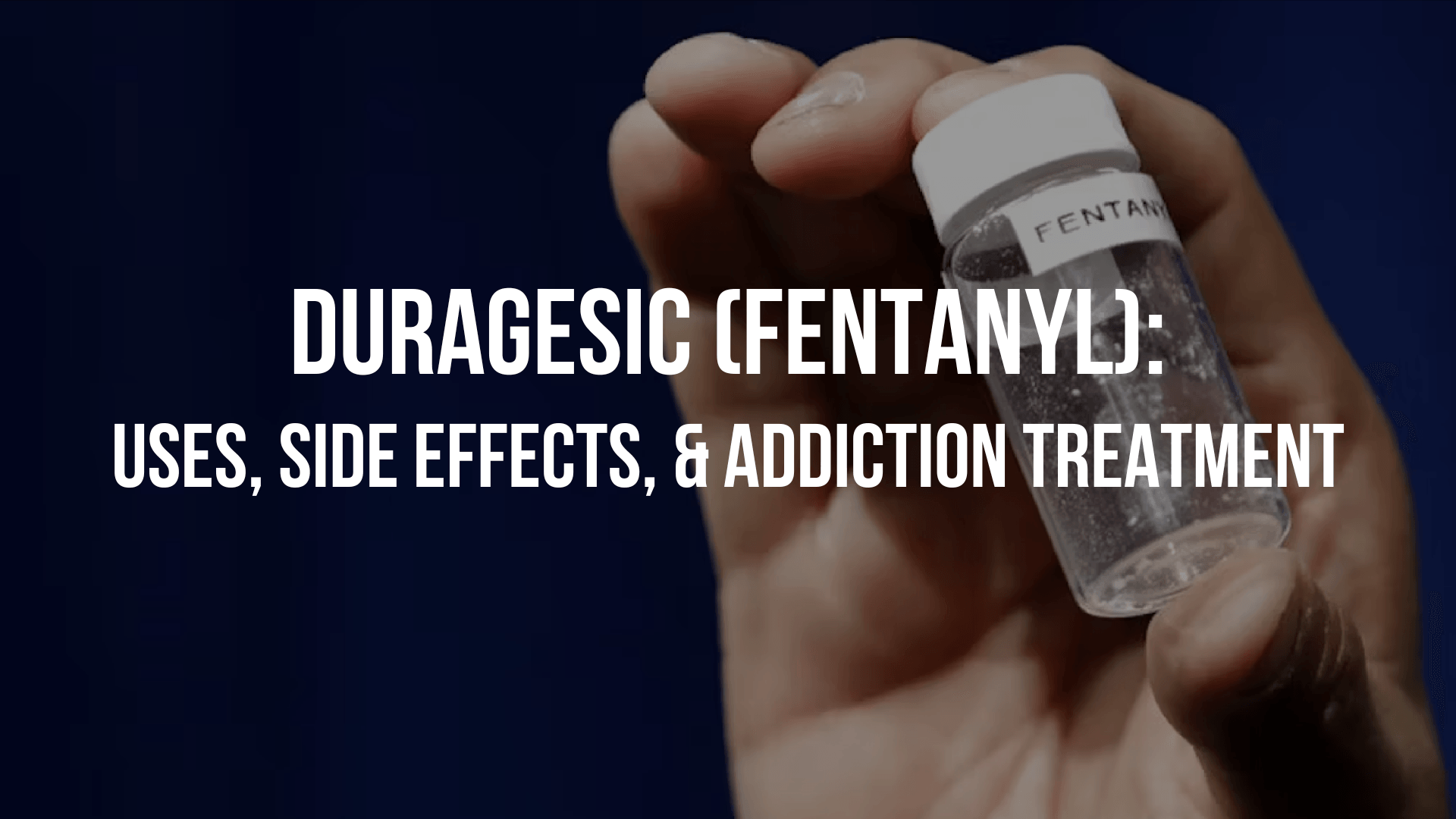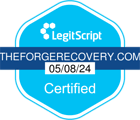Duragesic (Fentanyl): Uses, Side Effects, & Addiction Treatment


Duragesic (fentanyl) is commonly prescribed for pain management, but its addictive potential is incredibly high. Learn more and stay wary of fentanyl risks.
Curious about Duragesic (Fentanyl)? You’re in the right place. Discover how Duragesic is used, its potential side effects, how it interacts with other drugs, and more – and if you or someone you know is struggling with fentanyl addiction, contact The Forge Recovery Center today.
What Is Duragesic (Fentanyl)?
Duragesic, also known as Fentanyl, is a potent opioid pain medication often prescribed for severe pain management. It works by binding to opioid receptors in the brain, reducing pain sensations.
While it can be effective when used as directed, Duragesic carries a high risk of addiction and overdose if misused. It's crucial to follow your doctor's instructions carefully and only use Duragesic as prescribed.
Duragesic Uses
Duragesic is most commonly prescribed for pain management, often coming in a patch form rather than being administered orally. Here's a deeper look into Duragesic applications:
Pain Management: Duragesic is primarily used to treat moderate to severe chronic pain that requires around-the-clock opioid therapy.
Transdermal Patch: It comes in the form of a patch that you apply to your skin, allowing the medication to be absorbed slowly over a 72-hour period.
Long-Lasting Relief: By delivering a controlled dose of the opioid fentanyl, Duragesic provides continuous pain relief, which can be particularly beneficial for people with persistent pain conditions.
Non-Oral Administration: Unlike many pain medications taken orally, Duragesic offers an alternative for those who may have difficulty swallowing pills or experience gastrointestinal issues with oral opioids.
Diverse Applications: It's used in various situations, from managing cancer-related pain to providing relief for conditions like severe arthritis or neuropathy.
Always adhere strictly to your healthcare provider's instructions if prescribed Duragesic. Remember, it should only be used as intended – for safe and effective treatment.
Are You Struggling with Mental Health or Addiction?
We Can Help. Call Us Now!
CALL: 877-839-1772
What Are Some Duragesic Side Effects?
Duragesic use can result in a range of side effects depending on your individual reaction to the drug, including nausea, vomiting, drowsiness, and more. Everyone's body reacts differently to medication like Duragesic, so these side effects might vary from person to person. If you notice any severe or concerning side effects, it's essential to consult your healthcare provider as soon as possible.
Here’s a full list of Duragesic side effects to be aware of:
Nausea and Vomiting: You might experience feelings of queasiness or actually throw up after using Duragesic.
Constipation: Duragesic can slow down your digestive system, making it harder to have regular bowel movements.
Drowsiness: Feeling sleepy or tired is common when using Duragesic, so be careful when driving or operating machinery.
Dizziness: You may feel lightheaded or dizzy, especially when standing up quickly after using Duragesic.
Headache: Some people report getting headaches while using Duragesic, though this isn't the case for everyone.
Skin Irritation: Since Duragesic is a patch applied to the skin, you might notice redness, itching, or irritation at the application site.
Difficulty Breathing: In rare cases, Duragesic can cause respiratory problems, so seek medical help if you have trouble breathing.
Changes in Mood: You might feel more anxious, agitated, or even depressed while using Duragesic.
Duragesic Symptoms of Overdose and Abuse
Understanding the signs of Duragesic overdose and abuse is crucial for ensuring safe and responsible usage of this potent medication.Here is an outline of key symptoms to recognize if someone may be experiencing an overdose or misuse of Duragesic:
Respiratory Issues: You might notice difficulty breathing or shallow breathing. This could be a sign that you've taken too much Duragesic.
Extreme Drowsiness: If you're feeling excessively sleepy to the point where it's difficult to stay awake, it could be a red flag of Duragesic overdose.
Confusion: Duragesic can mess with your head. Overdosing might make you feel disoriented or confused.
Muscle Weakness: You might feel unusually weak or have trouble moving your muscles properly.
Slowed Heart Rate: Notice your heart beating slower than usual. That could be a sign of Duragesic overdose.
Cold, Clammy Skin: Your skin might feel cold and sweaty to the touch, which is another symptom to watch out for.
Loss of Consciousness: In severe cases of Duragesic overdose, you might even pass out or lose consciousness entirely.
Duragesic packs a potent punch, but misusing it can lead to grave repercussions. If you suspect an overdose, don't hesitate—seek medical assistance right away.
Are You Struggling with Mental Health or Addiction?
We Can Help. Call Us Now!
CALL: 877-839-1772
Combining Duragesic With Other Drugs
When Duragesic is taken with other drugs, it opens up a range of risks. Knowing these risks is crucial to ensure effective pain management and minimize the potential for adverse effects:
Central Nervous System Depressants: Mixing Duragesic with other central nervous system depressants like alcohol, benzodiazepines, or certain antidepressants can enhance the sedative effects, leading to excessive drowsiness, respiratory depression, or even coma.
Monoamine Oxidase Inhibitors (MAOIs): If you're on MAOIs or have taken them within the past two weeks, combining them with Duragesic can result in dangerously high levels of opioid effects, which may lead to serotonin syndrome or hypertensive crisis.
CYP3A4 Inhibitors: Some medications, like certain antibiotics or antifungals, can inhibit the enzyme CYP3A4, affecting the metabolism of Duragesic and potentially increasing its blood levels, which might lead to opioid toxicity.
Concomitant Illnesses: Certain medical conditions, such as respiratory disorders or liver impairment, can affect how your body processes Duragesic. Be sure to inform your healthcare provider about any existing health issues.
Be sure to communicate openly with your healthcare provider about all the medications you're taking, including over-the-counter drugs and supplements, to avoid any adverse interactions with Duragesic.
Duragesic Addiction Treatment Pathways
Duragesic addiction, or fentanyl addiction, is particularly deadly – highlighting the need for urgent intervention and treatment. If you’re curious about the treatment process, here’s a quick overview:
Initial Detox
The initial detox stage for synthetic opioids like Duragesic aims to manage withdrawal symptoms that occur when you stop using Duragesic, and is typically carried out at detox centers, hospitals, or addiction treatment centers. The most common type of outpatient detox is medication-assisted detox, which is short-term and involves the use of Methadone or Buprenorphine to combat withdrawal symptoms.
Inpatient Care
Inpatient care is typically associated with a hospital or medical center, where patients receive supervised and highly structured care for their drug and alcohol abuse. These programs offer treatment 24 hours a day, and individuals live onsite for the duration of treatment. Both inpatient hospitalization and residential rehab can offer counseling, medication management, case management services, and other steps of a comprehensive treatment program.
Outpatient Rehab
Outpatient rehab, on the other hand, is a flexible form of addiction treatment that allows you to go about your daily life while still receiving your scheduled therapies. Patients typically visit a treatment center, hospital, mental health clinic, or behavioral counselor on a regular basis during specific hours and days of the week. Outpatient fentanyl treatment can last three to six months, similar to inpatient treatment, and is a popular option for individuals who need to maintain employment while in recovery.
Aftercare
Aftercare involves ongoing support to maintain sobriety and prevent relapse. It includes various methods of support like peer groups, counseling sessions, and lifestyle adjustments. The success of this stage is pivotal in ensuring sustainable recovery. By developing a tailored aftercare plan, treatment centers can help you anticipate future challenges to your sobriety, so that you’re amply prepared to sustain your sobriety for the long-term.
Are You Struggling with Mental Health or Addiction?
We Can Help. Call Us Now!
CALL: 877-839-1772
Taking Control: Understanding Duragesic for Safer Pain Management
It's crucial to understand the risks and benefits associated with Duragesic. While it can effectively manage severe pain, misuse or abuse can lead to severe consequences, including addiction, overdose, and death.
If you’ve been prescribed Duragesic, always follow your doctor's instructions carefully and be sure not to exceed the prescribed dosage. Be vigilant for any signs of side effects or drug interactions as well, and seek immediate medical attention if you suspect an overdose.
If you or someone you know is struggling with Duragesic misuse or addiction, know that help is available. Reach out to The Forge Recovery Center for personalized care plans tailored to your needs or those of your loved ones. Don't hesitate to take the first step towards recovery and a healthier, brighter future.
Are You Struggling with Mental Health or Addiction?
We Can Help. Call Us Now!
CALL: 877-839-1772





